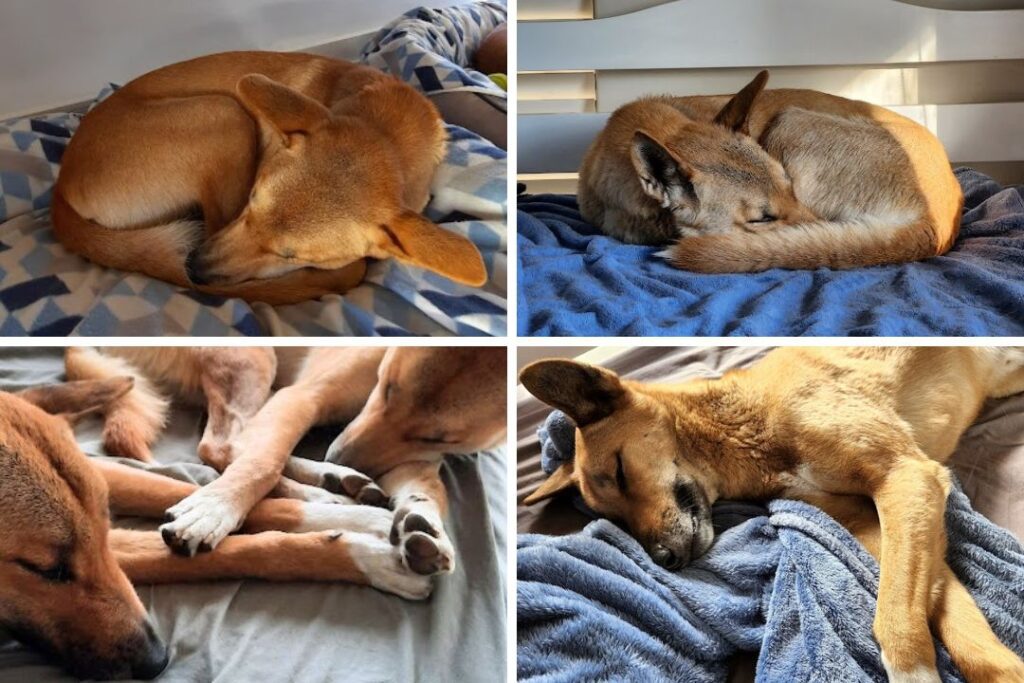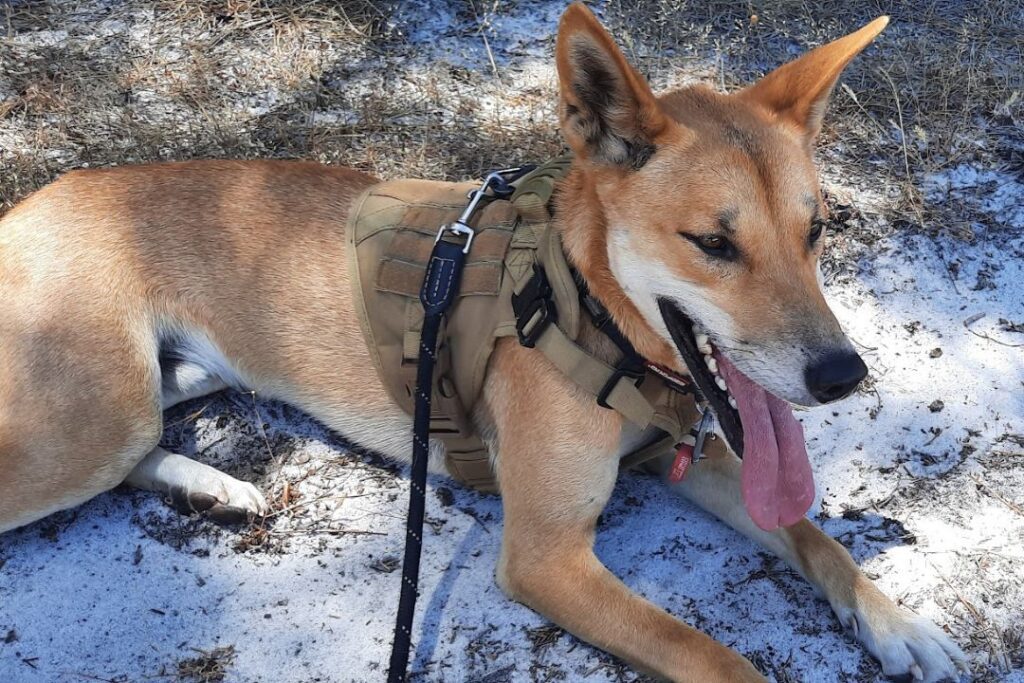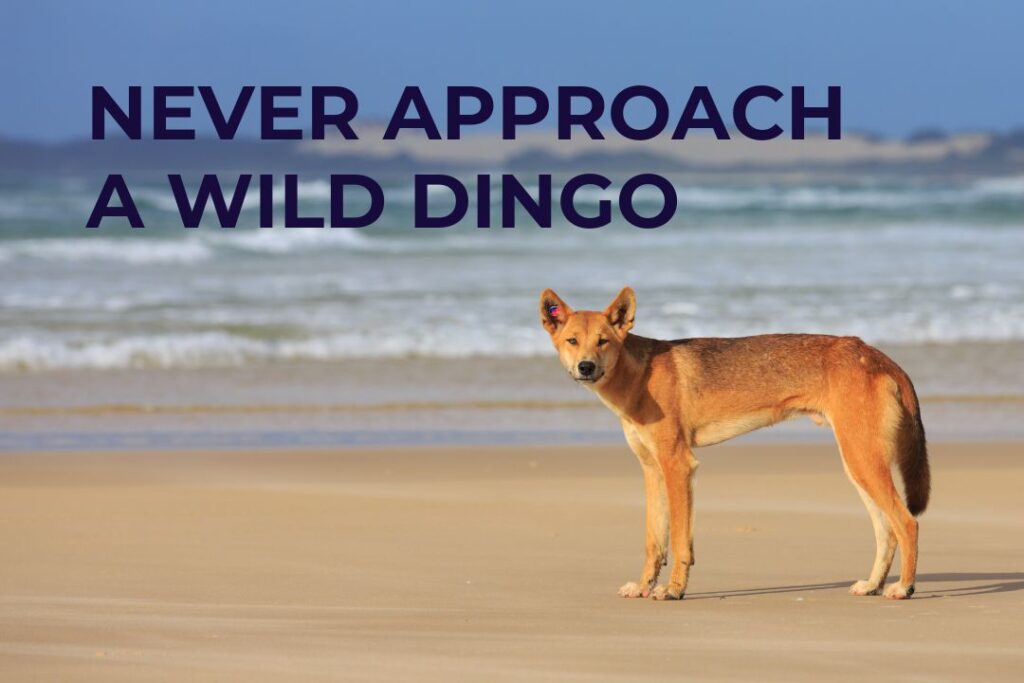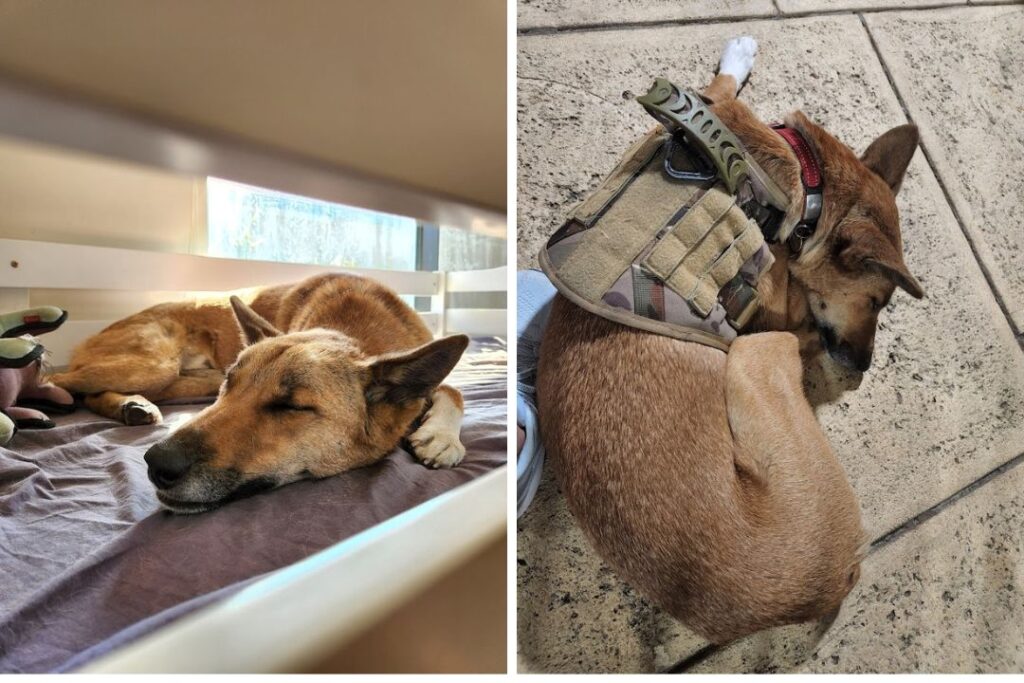Dingo behaviour was on my need-to-know list before saying yes to adopting a dingo. I needed to know what to expect and what a typical day might look like: how much do they sleep, how much exercise do they need, how do they communicate, do they get aggressive?
I had to know everything, because that’s who I am — I try to wipe out uncertainty with all the information I can find.
Dingo behaviour at home: a dingo guardian’s perspective
We have two adopted, wild-born dingoes in our family: Rusty and Jalba. They are the sweetest guys around and we’re so thankful to have them in our family.
We adopted Rusty when he was two and Jalba at five months old. Both were born in remote regions of Western Australia and both grew up without their families.
You can find out how we adopted them here.
Below, I’ll share what it’s like to live with Rusty and Jalba, with a focus on their behaviour and what you might expect if you are adopting a dingo.
Keep in mind that although there are some characteristics which are typical to dingoes, not all dingoes are the same — every dingo has its own personality and preferences. I’ve added some useful links at the end, in case you’re looking for scientific information about dingo behaviour, rather than a first person perspective.
How long do dingoes sleep?
If you’ve ever seen dingoes at the zoo, you’ll know they sleep a lot. Ours do now, but they didn’t always.
Bringing a new canine into a home will always require some settling-in time but for some reason, when it came to sleep, it took us 18 months.
In those first 18 months, they’d usually get up at least once during the night, and didn’t always return straight away, which meant we had to wait for them or convince them to come back inside.
Sometimes it was for a bathroom break, sometimes it was to gaze at the moon (ah, so cute) and sometimes it was for zoomies. Midnight zoomies were a problem because they’d often race through the house, causing a ruckus and waking everyone up, so we had to wait for them to come back in or we had to try and calm them down with the “nothing” game.
By some miracle, when Jalba was about two years old, they started sleeping through the night on most nights. They often put themselves to bed at around 8pm and sleep through to 5am.
If I didn’t normally get up at 5am, there’s a chance they might sleep longer, but Rusty is a creature of routine. If I’m not up by 5, usually, he’ll come down the hallway to wake me up, or he will quietly coo from his bed to wake me (thanks dude).
Some mornings they’re pretty active for an hour or two, but in winter they’ll stay curled up until 8am or later.
Dingoes sleep a lot during the day. Our adopted dingoes sleep most of the day, occasionally moving to new spots around the house or around the yard, soaking up the sun.
TL;DR: Adopted dingoes will likely sleep through the night and also sleep for most of the day.

How much exercise does a dingo need?
In the wild, dingoes can run up to 40km per day. Thankfully, you won’t need to walk or run 40km per day with adopted dingoes.
We walk our dingoes so they can stay strong and healthy, so they can be calm at home and to provide their minds with enrichment.
For our dingoes, a daily walk of at least 30 minutes is ideal and practical for our family. When possible, we take Rusty and Jalba for longer walks lasting anything from an hour to several hours.
If we’ve been busy and haven’t been able to take our dingoes for a walk, we use the flirt pole to help burn our dingoes’ energy or we train them by playing games or provide other enrichment such as frozen Kongs or likimats.
How we walk our dingoes
We generally walk at a slow pace, giving our dingoes time to sniff and explore. Sometimes in 30 minutes, we only cover 2km.
We usually walk in pairs, for safety and comfort. Even if we wanted to walk them separately, I don’t think we could. When we’re out for a walk, if they can’t see each other, they get anxious, turning and looking, whining quietly until they are within sight of each other again. Likewise, if any members of our walking group fall behind or out of sight, they’re not happy about that either.
Rusty and Jalba are becoming great at walking away from potential prey, but sometimes they need convincing that chasing those kangaroos or that lizard is not a good idea and it’s a bit hard to do that if one person is walking two dingoes alone.
Each dingo wears a harness attached to a lead, and their Martingale collar is also attached to their harness. I also use a slip lead as an extra precaution. Dingoes are very flexible canines and can escape from normal collars, even Martingale collars and many types of harnesses. They also have a high prey drive, poor recall and strong fight or flight instincts, so having the slip lead gives me some peace of mind that if they manage to escape from their harness, they’re not going to run in front of a car or chase kangaroos.
Currently our dingoes wear harnesses from Pet Belong, which are sturdy and have a close fit across the chest, between their front legs and around their bellies. These are great harnesses but our dingoes still have the ability to somehow throw these harnesses off, thanks to their intelligence and flexibility.

Dingoes and recall
A general characteristic of dingoes is that they have poor recall, even with training. This means that if you’re looking for a four-legged friend who can run off lead and return to you straight away, every single time, a dingo is not for you.
We know of and have seen some exceptions, and we have no doubt that ours would eventually come back to us, but reliable recall is not a characteristic that our dingoes possess. They know their names, they have some recall, but definitely not reliable recall. For this reason, they are never off-lead in public.
Where we walk our dingoes
We used to walk around suburban neighbourhoods and up at a regional park, but dingoes can be a little fearful of strangers, bikes and dogs, so we’ve found that it’s easier to walk them in quieter places.
The biggest challenge of walking dingoes is when we come across off-lead and out of control dogs. We’ve come across a number of off-leash dogs which have not been within sight of their owner and have not had adequate recall, putting us all in a dangerous situation.
We’ve also seen dogs on lead but are high risk, such as a cute toddler walking her little fluffy dog, a young teen walking a large dog without much control and a man with a retractable leash.
If you use a retractable leash in a populated area, please restrict the length of your lead and keep in mind that some local councils have restrictions on lead length for this very reason.
One afternoon our dingoes were on leads, far from the footpath, waiting patiently for a bull terrier and its owner to pass. Unfortunately, the owner wasn’t paying attention and his dog made it up to our front porch in a flash. Nothing happened but it didn’t take long for the owner to realise that things could have escalated quickly.
When introduced slowly, our dingoes can be great when meeting new dogs, but when an off-lead dog runs up to them unexpectedly, this causes their fight or flight instinct to kick in. People with off-lead, out of control dogs are a problem, not just for us as dingo guardians but also for many, many dog owners.
Fortunately we have plenty of open spaces near us that aren’t frequently visited by people and their pets, so we usually walk in beautiful bushland and forests nearby.
TL;DR: We walk our dingoes for about 30 minutes each day, in bushland and forests, away from busy neighbourhoods and off-lead dogs.
Dingoes and food
Keep in mind that this article is about dingo behaviour, so I’m not going to cover what they actually eat.
Our dingoes eat their main meal once a day, usually between 12 and 3pm, but you could choose whatever time works for you and your dingoes.. Sometimes our dingoes will have additional food, such a Kong, likimat or a cup of grain-free kibble.
When they are young they require a little extra food, so when Jalba first came, he got to have breakfast and we fed Rusty a little breakfast too, so he didn’t feel left out.
If Rusty’s feeling hungry or he thinks we’ve forgotten, he’ll brush past me, sit or lie next to me or start quietly following me around. He’s really quite sweet and will wait if we tell him to, but if I get up from my desk anytime from 1pm, they’re on high alert and will jump up ready for lunch.
They’ve also learnt to find our kids if they are hungry… not because they are the food but because they take turns feeding our dingoes.
Dingoes and resource guarding
There is some resource guarding, so we feed them separately. We feed our dingoes at the same time, but give Rusty his food first. Rusty eats inside and Jalba eats outside. This helps them feel less threatened by each other and reinforces their hierarchy with Rusty being The Boss.
We try to minimise resource guarding by ensuring they sit before meals, by hand feeding and by dropping occasional treats into their bowls while they’re eating. We also ensure every family member takes a turn to feed them, to remind them that we’re their provider and not a threat to their food.
If they’re full, dingoes tend to hide their food for later, which we’ve seen them do a few times. To avoid potential fights, we are careful not to overfeed them and we very rarely give them treats that take a long time to consume. Before we had Jalba, Rusty devoured a kangaroo rib cage and gnawed on a kangaroo foot for quite a while, but with two dingoes and potential for conflict, we don’t do this anymore.

Dingoes and their prey drive
Dingoes are carnivores and apex predators with a high prey drive. When we go for a walk, our dingoes can hear and see prey before we can. We keep a look out for blue tongued lizards which are often basking in the sun, and veer away if we see any.
If our dingoes see a wild rabbit, emus or a mob of kangaroos, in the past they would obsess and pull wildly on the lead, but now they’ve developed the ability to look, get excited and walk away when we ask them to.
Dingoes and pocket pets
If you look at dingo adoption notices, you’ll notice they usually state that homes with pocket pets are not suitable — small creatures like mice and guinea pigs.
We already had guinea pigs when we adopted our dingoes, so we put a plan in place to keep them separate. We also had frank discussions with our oldest child, to make sure they knew the risks and what we would have to do to keep all our animals happy.
So our guinea pigs were always behind a closed door, in a secure cage and we also put up a safety gate to discourage our dingoes from entering our kids’ hallway. In addition, we changed all our door handles to door knobs… FYI, dingoes can open door handles with ease.
TL;DR: Our adopted dingoes eat separately once a day. They have a high prey drive and it’s not a good idea to adopt a dingo if you have pocket pets.
Dingoes and communication
Something I never predicted was how easy it would be to communicate with our dingoes. Most of the time, we know what they want, they are super clever at communicating and they seem to know what we’re saying too.
Do dingoes bark?
You may have heard the term, “dingoes don’t bark” but it’s a bit of a fallacy.
It’s true that dingoes don’t bark like dogs — there is no repetitive “woof woof” or “yap yap”, which is wonderful. Dingoes bark on rare occasions, to communicate specific things.
I’ve read that a dingo might bark at her cubs to call them back, but in our case, our dingoes bark to communicate warning or dislike. Jalba regularly barks at the vacuum if the nozzle comes anywhere near him and Rusty has barked to let me know a person was peeking over the back fence, someone we didn’t know.
Do dingoes growl?
Yes. Dingoes growl for a number of reasons, such as warning, fear and simply to play. It’s easy to differentiate between their intentions and there is only one type of growl that is ever directed at us. Most of the time, our dingoes don’t mind being approached while they are sleeping and often they’ll stay asleep because they know us, but sometimes, if Jalba is approached while sleeping or if either has had a hug that is too long, they give gentle growl, so we try to keep our hugs very brief.
Do dingoes howl?
Our dingoes howl a few times a week, sometimes a few times a day. They do not howl constantly and they generally only howl in response to something, such as aeroplanes or the blender.
Rusty is usually the instigator, and he understands when we tell him to stop, but sometimes once they’ve started, we’ve just got to let them get it all out. To be honest, the sight and sound of dingoes howling is beautiful — one of our neighbours even said they turn down the TV so they can listen.
If it’s early morning or after 7pm, we try to catch them before they howl, by telling them to stop, keeping them company or calling them over for cheese, which works about 80% of the time. Early morning Kongs and likimats can also help.
Rusty has a few different types of howls; he’s an interesting character. I’ve shared a few dingo howling videos in my Instagram reels; you can also check out Fred and Adina from the Australian Reptile Park below.
Huffing or chuffing
Rusty doesn’t really huff or chuff, but Jalba does. When Jalba is feeling wary, the fur on his hackles will rise and he chuffs through his nose, letting out quick puffs of air. He did this when our back neighbour was poking her head over the fence and when the air con technician walked briskly into the house. Dingoes need a slow introduction to people, so unexpected strangers can make them quite anxious and wary.
Do dingoes whine?
Definitely. If they haven’t been for a walk, Rusty and Jalba will often lay at the safety gate, paw at it and whine for a walk. This is usually a loud, long whine. If they hear us putting on our hiking boots or hats, they’ll start pacing and whining, anticipating their walk.
They also do short, quiet whines. Our dingoes usually do this if they’re worried or anxious or want to be closer to us. For example, Jalba will pace and whine if something is out of the ordinary in the backyard, or if I’m in another room (but not always, thankfully!).
Do dingoes chortle?
Out of our two dingoes, Rusty is the chatterbox. I don’t know how to describe this sound, but Rusty likes to talk. If he is bored and desperate for some extra food, he sits in front of the kitchen gate, looks me straight in the eye and tells me so. I’ll have to post a video recording or sound recording so you can see. I can usually tell if he’s legitimately hungry or if he’s just trying his luck.
Jalba has a lot to say when we’re preparing his dinner but it’s less of a chortle and more of a whine.
Do dingoes yelp?
Yelping is another sound that we often hear when they’re playing outside. Usually it’s Jalba yelping because Rusty is being too rough or Jalba needs a break.
TL;DR: Dingoes growl, howl, chuff, whine, chortle and yelp. On rare occasions, they also bark.

Dingoes and training
Dingoes are independent, stubborn canines, but they’re also very smart. We’ve found that our dingoes are food-driven when it comes to training, and they respond to the training we have done.
If you’re into dog shows, a dingo is probably not right for you, dingoes are not likely to do a behaviour unless they have a reason to do so.
Dingoes and family
Our dingoes are very much family and they’re so comfortable and content at home that we think that they feel like part of the family. They love pats and belly rubs and can often be found asleep next to us as we go about our day.
They absolutely love it when anyone arrives back at home. When they hear one of our cars arriving in the driveway, or a gate being unlatched, they sit up, their ears perk up and often they’ll run outside to see and hear as best as they can.
Once we come inside, we’re greeted with Rusty’s “Aw-ooo!”, they run to us with their tails wagging and their ears back and down. We bend down to pat them and they do a lot of sniffing and licking.
They’re most happy when they’re with us. They seem to get anxious when no one is home or if we’re in other parts of the house for too long. Lucky for them, I work from home, so I’m right beside them nearly all day. Click here to find out how our rescue dingoes show affection.
Dingoes and strangers
Dingoes are quite wary of strangers —they take time to warm up to people. When people enter our home and meet our dingoes for the first few times, we ask the people to ignore the dingoes and not to pat them. In time our dingoes will approach and have a sniff. And then we repeat it and make sure they understand.
Rusty is usually the first to feel at ease, he’ll either go to bed or lay down near the person. Jalba is usually more wary — he’ll pace for a while, keep his distance and try to get closer for a sniff.
Later, even once our dingoes appear to be comfortable, we still remind our guests not to touch or feed our dingoes, not until we recognise that our dingoes are ready. The reminders are so important and necessary — dingoes are very very adorable and it’s easy for others to misjudge how our dingoes are feeling.
Dingoes can be very jumpy and with their fight or flight response in mind, we take care that our guests never inadvertently block our dingoes into a space (e.g. hallway).
MUST READ: It’s very very important that you never ever approach a wild dingo. Never feed a wild dingo and never touch a wild dingo. If you see a dingo in the wild which appears to need assistance, call your local wildlife service.

Dingoes and strange places
I’ve read that dingoes bond not only with their family but also their environment. It makes sense that they feel at home at our house, that they’re comfortable here and that they relax.
Our dingoes become anxious walking along busy roads and even travelling to new places in the car, no matter how near it is.
The Dingo Den points out that “a dingo’s senses are five times more acute than the average dog’s” which means that dingoes can “easily become overstimulated, and therefore overwhelmed and distressed when exposed to a multitude of noises and scents like those found in a busy public setting.”
We recently had a major bushfire nearby and we had to evacuate. Thankfully we were able to take our dingoes to our family’s house, as they had an enclosed patio area. Even though one of us was with our dingoes every second, our dingoes were anxious the entire time. They slept occasionally but Jalba was pacing all through the day and night, whining his distress. Once we got back home, they went straight to sleep and were happy to be home.
There are a number of dingoes which do great in new places, dingoes which are trained to interact with the public, visit public places and even dingoes which travel around Australia with their family. As with any canine, early exposure would probably help.

Dingoes and destruction
Dingoes can be destructive, but not always.
In Rusty’s early days, he chewed a seatbelt and ripped down six fly screens — all were due to anxiety when he was coming home and settling in. Jalba chewed the corners of furniture, but that too was in his early days, when he was five months old and new to our home.
They don’t rip up our furniture anymore but they’d gladly play with and rip their own!
If one of our kids drops a sock or flip flop, our dingoes steal that in a flash, but they never steal anything of value, partly because we avoid leaving things lying around but also because they’re smart — they know what they can take without getting into trouble, things like Covid tests, empty cardboard boxes or ice cream sticks.
Our books are jammed in pretty tight, but sometimes we find the odd book has been chewed on when we’ve left them home alone. We’ve blocked off the bottom half of our bookshelf so we can avoid losing our library.
Dingoes are escape artists
If you’re looking to do a jailbreak, a dingo is your friend. Dingoes are smart, flexible and determined creatures.
Our dingoes can open doors, open and break down safety gates, jump over barriers, squeeze through tiny spaces, sneak into rooms and dig the deepest dens. Proportionally, dingoes have narrow heads compared to dogs, which means if their head fits, their body fits.
Our dingoes have never tried to escape — they know that our backyard and our home is their safe space. They never try to jump the fences or go through gates, they never try to rush out through the front door. High fences are essential when you have adopted dingoes, you can read about dingo-proof fencing here.
My last words on dingo behaviour
What I’ve written above is my own experience with our two adopted, wild-born dingoes. It’s worth repeating that dingoes have unique characteristics compared to domestic dogs, however each dingo has its own personality and what we experience in our home will vary from others in their homes.
There are a few aspects of dingo behaviour which I haven’t covered, such as breeding season, as this doesn’t apply in our situation. There’s a lot to learn about dingoes and I hope the links below are helpful.
More information about dingo behaviour
Looking for scientific info about dingo behaviour? Here are some links to get you started:
- The Australian Dingo Foundation
- Dingo Den
- Research by Dr Kylie Cairns such as this article on ABC News
- Dingo (Australian Natural History Series) By Dr Brad Purcell
- Research suggests that more than half of Australia’s dingoes are genetically pure, not hybrids
- The Dingo Debate: Origins, Behaviour and Conservation By Dr Bradley Smith

wow that’s how dingoes behave? that’s so… so… interesting!!!!